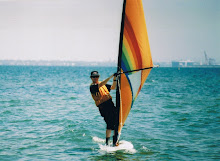In the last posting Shapers Australia was mentioned as being a good one-stop shop with pretty much all of the materials required to build the longboard. One thing that caught my eye was a set of DVDs featuring tutorials from some of the top guys in the surfing scene in the areas of shaping and glassing boards. So I lashed out and ordered Shaping 101 (took me back to those hazy days doing Maths and Physics 101 at Uni) by John Carper, a guy who seems to be pretty well known in surfing circles (i.e. check out the following interview in TransWorld Surf). Haven't had time to check out the entire DVD as yet, but it does appear to be full of good practical advice with respect to board shaping, and I've already learned a lot.
I just love how the years of surfboard shaping has made John Carper so sk
 illful yet so casual. Here he is introducing one of his high tech cutting tools know as the hand saw. He then proceeds to demonstrate how you cut out a board outline in 20 seconds flat- no hesitation and perfectly square. I'll be sticking to that old adage measure three times and cut once- slowly.
illful yet so casual. Here he is introducing one of his high tech cutting tools know as the hand saw. He then proceeds to demonstrate how you cut out a board outline in 20 seconds flat- no hesitation and perfectly square. I'll be sticking to that old adage measure three times and cut once- slowly.The goal now is to have a first design put together over the next couple of weeks. At this stage the materials are firming up as H-grade polystyrene foam; 6 oz glass on the top and
 bottom with a layer of carbon fibre over the working area of the board (i.e. from the tail to the tacking area in front of the mast track; carbon fibre tape over the remainder of the rails and nose; marine ply (thin) reinforced with glass for the centreboard case; foam+carbon fibre for the centreboard; tuttlebox for the fin (not sure whether to build the fin as yet or to purchase) ; and perhaps something innovative (and drawn from dinghy sailing equipment) for the mast track.
bottom with a layer of carbon fibre over the working area of the board (i.e. from the tail to the tacking area in front of the mast track; carbon fibre tape over the remainder of the rails and nose; marine ply (thin) reinforced with glass for the centreboard case; foam+carbon fibre for the centreboard; tuttlebox for the fin (not sure whether to build the fin as yet or to purchase) ; and perhaps something innovative (and drawn from dinghy sailing equipment) for the mast track.Bye for now.
